Evamarie J
.png?width=800&name=2023.Q4%20-%20Blog%20Banners%20-%20Legacy%20Blogs%20(4).png)
Introduction to the Blog Summary
This blog explains the importance of conducting a competitor audit, outlining its benefits and providing practical steps to help brands gain valuable insights and maintain a competitive edge.
Key Points Overview
Top Takeaways
Conclusion
Conducting a competitor audit is essential for understanding market dynamics, identifying opportunities, and staying ahead of the competition. Utilizing tools like Quid® can streamline the process, providing actionable insights for strategic decision-making.
The biggest mistake many brands make is trying to win while remaining oblivious of the competition. They identify their competitors, but do little else. This doesn’t necessarily add anything to their arsenal––and every bit of intel should. Let’s clear things up!
You must know your competitors like a financial auditor seeks to know an organization’s accounts through its books. In other words, you shouldn’t take what you see at face value but go deeper if you are to compete effectively. A competitor audit is the cornerstone to gathering vital competitive intelligence, understanding how you compare, and helping you get ahead. And to that end, we have prepared this guide to help you get close enough to your competitors, if not to disarm them, and to know where you stand in the market. If that’s sounds daunting, follow along for some tips to help you accomplish it!
So, why conduct a competitor audit in the first place? Why leave the comfort zone that so many average businesses seem to enjoy? Here are five concrete reasons why you must go through the process.
Emerging competitors are arguably the hardest to spot. New entrants into the market often present new products that may not always seem like viable alternatives for the customers of existing companies. But it is not uncommon for established brands to be dethroned this way.
History is rife with tales of companies that died of complacency. Blockbuster was a big company capable of running thousands of DVD stores across the country. It was dethroned by an entrant called Netflix that lacked the budget but had the mind to rent out DVDs through the mail. It’s probably the main reason why you don’t “Blockbuster and chill” today.
Performing a competitor audit can help you in the same way whether you are an established or growing brand. By identifying emerging competitors and products you can make strategic decisions on how to survive new waves
It’s no longer surprising the sway that social media has on consumer buying decisions. But it’s not so much about social media the tool itself but rather the access that it gives to the user.
The modern consumer is able to instantly reach thousands of family, friends, acquaintances, and strangers whenever they need to know more about a product or brand. In doing so, they join ongoing conversations about existing options in the market. This helps them make the decision. Research shows that 71% of buying decisions are made this way.
Share of voice refers to how different brands feature in these consumer conversations. To this type of consumer, products that aren’t being mentioned on social media are virtually non-existent.
A competitor audit shows you who is dominating the conversation in your category and how big your share is. In the modern environment share of voice is directly proportional to potential sales.
Success in marketing depends on knowledge of one’s target audience. If your marketing messaging doesn’t appeal to the recipient, there is no way you can convince them to take the next step.
This is not the only problem with not understanding your target audience. There are reports that brands collectively lose more than $37 billion annually simply by targeting the wrong consumers. According to Google, 56% of ad impressions never reach the consumer. It’s expensive not to know your audience.
How does a competitor audit help fix this? Well, both you and your competition are targeting the same consumers. By learning where their focus is, you have automatically identified your target audience. But not so fast. You are able to determine this depending on how effectively they seem to reach the audience. It makes your work easier if you can at the same time replicate their successes and avoid the mistakes.
Many brands make use of influencers and key opinion leaders (KOLs) to disseminate their marketing messages on the internet. These groups of people have tremendous reach and influence over consumers and each has their unique sway.
Influencers are trusted voices that promote products and services they are affiliated with. Consumers take their word because they believe they have used the products themselves. KOLs on the other hand are trusted for their expertise in particular fields. Consumers have a high regard of their opinion because they are believed to be impartial. They have more credibility than influencers, and influencers have more credibility than the brand does when talking about itself.
You can use the influence of both to the advantage of your brand, if only you know them and how to reach them. Using Quid®, you can filter search your competitors to discover the influencers and KOLs you need. You can even analyze the success they have had before reaching out to make sure you only contact the best. Understanding how to connect with them is key – read more about what KOLs are and how brands should work with them here.
Needs left unaddressed by your competition are exploitable opportunities for your brand. These gaps in the market come in different shapes and sizes, as you will realize during your competitor audit.
Sometimes, a gap exists in the form of an inconvenience to the consumer. At other times it is an inefficiency in the business model. It may also be a marketing issue. It can even take the form of a small differentiation or niche in the market.
Before addressing the gap, you must examine it and see why it exists in the first place. Is it an oversight, negligence, ignorance, or what? An effective competitor audit can help you answer these questions satisfactorily.
Now since we know that a competitor audit is essential for your business success, let us see what it takes to realize the benefits just discussed.
Emerging trends are like a peek into the future and you need to track them as part of your competitor audit. You may be surprised to know that established organizations like BCG are particularly interested in the unknown startups in their industry. But you needn’t be. Uncovering emerging trends tells you where the market is headed and helps you prepare.
Below is an example of a visualized data analysis, showing trending conversations about the supply chain in the wake of the pandemic:

And below, as the supply chain conversation begins to climb, we see German automaker, BMW, was watching the news early and preparing its supply chain response ahead of the pack:
.jpg?width=593&height=333&name=supply-chain-conversation-timeline-1%20(1).jpg)
How did they know? We can be sure their moves weren’t by chance, rather they were data-driven.
On the same strain, let us discuss the role of news media in helping you conduct a proper competitor audit. News media can give you much information on your industry including which competitors are launching new products, who is merging with or acquiring whom, what events are taking place and where, and much more.
In the analysis below by Brunswick Group, an advisory firm, on behalf of a client, we can see top companies and themes in the energy sector, which are then monitored for fluctuations in volume, shifts in engagement and other important indicators.
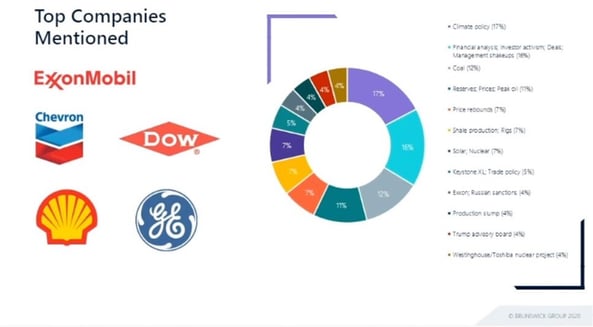
To determine share of voice, you should track brand mentions across the platforms to see how your competition—and your brand—are featured in consumer conversations. Share of voice will help you understand brand awareness as well as engagement among social media users.
You will find Rival IQ to be an invaluable addition to your toolkit during your social media competitor audit. It shows you what your competition is up to in real time, from the numbers to changes in messaging:
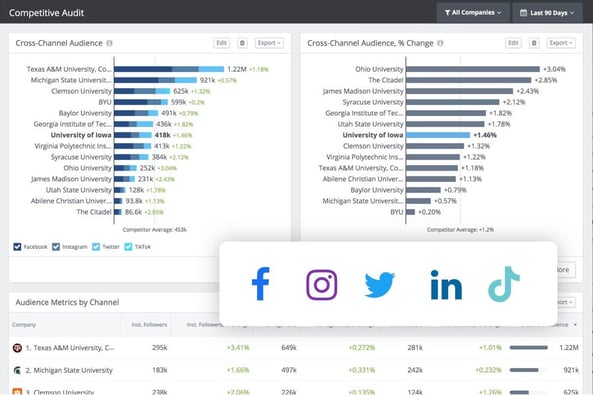
Moving on from share of voice, sentiment analysis helps you get a clearer perspective of the landscape. You could have an impressive share of voice but it could also be mostly negative. You want a good share of voice, but you also want the consumers to love you.
Examine the following brand passion index prepared for three leading fast food brands. They all were analyzed using social media mention data collected within the same month.
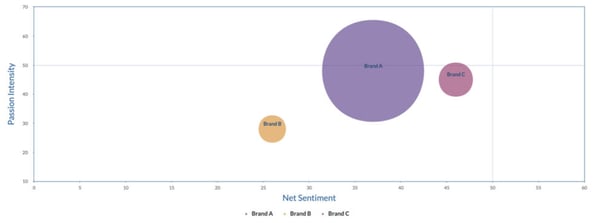
Interpretation: Brand A dominates the category in the volume of mentions and takes a close lead over Brand C in passion intensity. Brand C on the other hand leads in net sentiment. Lagging on all three measures is Brand B. If it was Brand B that did this examination, it would still be better off than if it didn’t do it at all. At least now it knows where it stands and can take measures to catch up. Whether you end up as brand A, B, or C, a competitor audit really opens your eyes to the situation.
You have to look at what the competitors’ customers are saying. Customer review analysis tells you about the utility of the products and services sold by competitors from the horse’s mouth.
Customer reviews are part of the data that Quid® finds when scouring the web for consumer and market intelligence.
Search engine data includes keywords and product searches. The perfect tool for this is Google Trends and it’s also free, courtesy of Google. It’s a good way to know the queries that are most sought after (they are the most searched). It is also a great addition to the trends data.
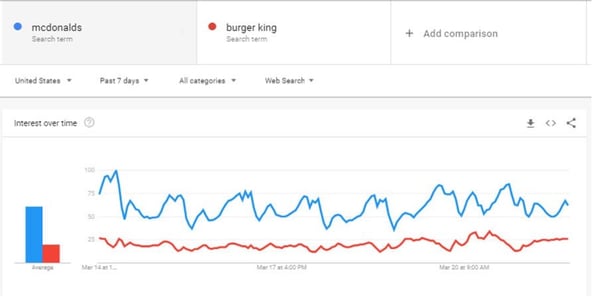
While Google Trends won’t tell you who is doing the searches, the data is well organized for quick interpretation. For product searches, you can easily identify your competitors by their brand names and rank your own against them. For keywords and keyword phrases, you can analyze the content posted by your competition to infer their SEO efforts
Don’t shy away from monitoring your competitors’ advertising activities. How they are spending their ad budget will reveal not just what they are most concerned about but also something about the size of their treasury.
For this, you can use a tool like AdBeat, which focuses primarily on display ads. (For search ads, checkout SpyFu, another great tool to add to your competitor audit toolbox.) AdBeat will show you the visuals and copy of the ads so you can understand their language, traffic sources to complement other information you already have, and the amount of money spent on the ads.
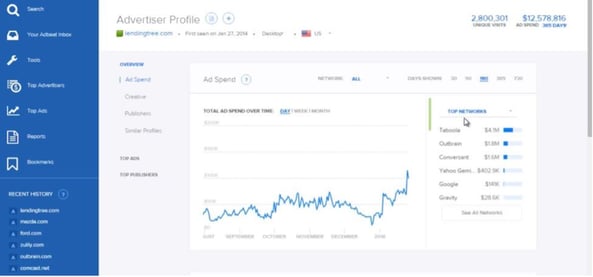
Quid Connect and Opus Upload allow you to integrate your data so you can complete your competitor audit efficiently no matter how many third-party tools you use in the process.
Ready to conduct your own audit? Download our free template to get started!